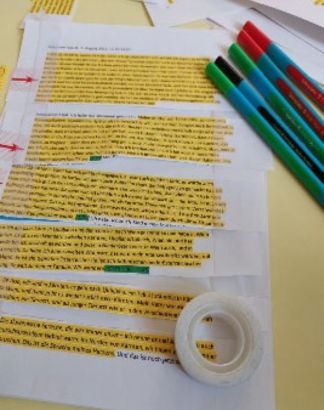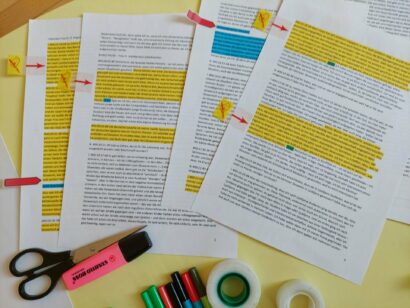Within the framework of our project, each partner institution chose a specific moment in contemporary history to which contemporary witnesses tell about their lives. Excerpts from the interviews were published as short video clips on the method platform. A total of 19 video clips and one audio clip were produced.
 Editing video clips for publication is a creative process. It requires selecting relevant passages from an editorial point of view and combining them into a new, shortened narrative. Inevitably, the editor’s perspective always flows into this new narrative. Nevertheless, the skill for this procedure lies in not distorting the content and preserving the character of the narrative, despite shortening the text. The interventions in the interview by cutting can be revealed, follow-up questions from the interviewer can be included, and black fade-outs can indicate time jumps in the narrative.
Editing video clips for publication is a creative process. It requires selecting relevant passages from an editorial point of view and combining them into a new, shortened narrative. Inevitably, the editor’s perspective always flows into this new narrative. Nevertheless, the skill for this procedure lies in not distorting the content and preserving the character of the narrative, despite shortening the text. The interventions in the interview by cutting can be revealed, follow-up questions from the interviewer can be included, and black fade-outs can indicate time jumps in the narrative.
There are different approaches to transcribing spoken in- terview passages. For scientific analyses, pauses in speech, repetitions, and slips of the tongue are recorded as relevant events in the transcription.
For the publication of biographical interviews in the context of adult education, an intermediate position can be taken. On the one hand, what has been said must be authentically reproduced, on the other hand, editorial interventions in favour of the readability of texts – for example, subtitles – are possible. The sentence order of the spoken language can be adapted to the reading habits, repetitions can be omitted.
Practice, implementation and experiences in the project
Filming of the interviews
During each interview, a fixed camera – ideally with a tripod – was set up, which was not moved. It rests exclusively on the narrator, the interviewer is not in the picture. The video recordings per interview are between one and two and a half hours long.
Editing of the video clips
Excerpts from each interview were edited into three to 15- minute video clips. These video clips provide insight into the different narratives on the project’s method platform. The video clips also formed the source material through which cultural workers entered into a sensitive dialogue with the narrators. In this way, an exhibition and a theatre performance were created.
Transcription and subtitling of the video clips
The spoken text of the video clips was transcribed by the project partners and translated from German, French, Swe- dish, Croatian and Polish into English. When the inter- viewee speaks (too) quickly, the translated text had to be shortened or compressed, so that the subtitles are easy to read and following the narrative flow is possible.
Release of video clips by the interview partners
Most interviewees agreed to the release of the video clips. They signed release forms for the use of their text in the project. One interviewee only agreed to the audio recording of his interview. In this case, only the audio track is pub- lished on the method platform. Another interviewee agreed to the video recording, but did not want to be recognizably pictured. In this case, her image was partially pixelated.
Potential of the method for transnational and multi-perspective approaches
The content of the interviews
First of all, the transnational aspect is in the content of the interviews conducted with people whose life experiences cross national borders. Each interview reflects personal perspectives on events in the past that go beyond national his- torical narratives. If, as in the present project, several interviews are placed next to each other, this alone gives a spectrum of perspectives.
Reflecting on the publication process
The publication process itself requires an in-depth, multi-perspective reflection of the narrated content. On the one hand, the dignity and integrity of the interviewee must be preserved (respectful treatment of the entrusted texts and images, etc., no distortions of the content). On the other hand, ethical questions in dealing with ideologically coloured statements of the interview partners, such as stereotypes, politically incorrect statements or racism, etc., must be discussed and clarified in the editorial team or in the learning group.
Finally, the editor has to respond to a future audience, e.g. with regard to length and comprehensibility of the text, arc of suspense and conclusiveness when stringing together interview excerpts, and much more.
Subtitling and translating
Sensitivity and understanding of text and language are re- quired when transcribing spoken texts for subtitles, when interview statements need to be compressed linguistically to accommodate the reading habits and pace of the audience. Transnational aspects also arise when subtitles are translated into other languages. The vocabulary of historical events can diverge in different languages and refer to national perspectives.
Workshop: Editing of biographical interviews
Excerpts from each interview were edited into three to 15- minute video clips. These video clips provide insight into the different narratives on the project’s method platform. The video clips also formed the source material through which cultural workers entered into a sensitive dia- logue with the narrators. In this way, an exhibition and a theatre performance were created.

Material
- Paper printouts of the biographical interview transcript – if possible with time codes for each paragraph so that participants can estimate the length of the text excerpt;
- scissors, glue;
- large table surface;
- space for several small groups.
Task
Cut a 5-minute clip from the existing transcript of an overall interview of about 90 minutes. Select relevant passages of text and assemble them into a new, abbreviated version of the text maintaining its message.
Procedure
Small group work: The selection of text passages and their compilation into an abridged narrative is done in small groups or in pairs. They discuss their text selection during the working process.
Plenary reflection: In the plenary, each working group presents the produced text version and the underlying editorial decisions. In a more in-depth step, the working groups’ text results can be compared and characterised. No newly produced narrative will be the same as another. This reflects the creative intervention in the original narrative and the subjective view of the learners.
Duration: four hours.
Tools
For tools and further materials and documents please refer to the method platform of the project:
Preparatory hints for recording a biographical interview
Template for preparing subtitles
Template Declaration of consent
